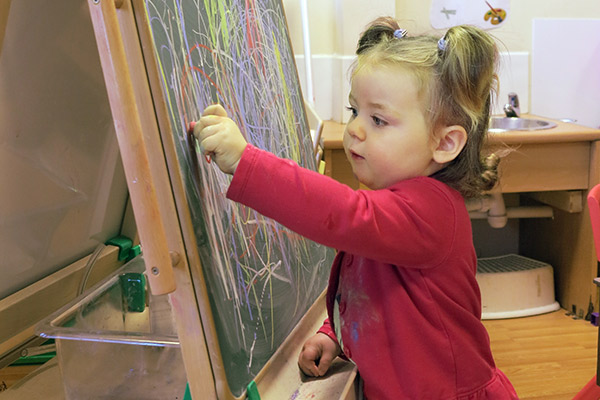Supporting sensory development
Helping children to thrive at home and at school
| July 2020Young children develop best through directly engaging with their world, moving and exploring with their senses and taking in information from their environment. While we generally think of ourselves as having five senses, we actually have seven: vision, hearing, taste, smell, tactile, vestibular, and proprioceptive. Think of your vestibular sense as your body’s ability to manage its balance and motion in space, while the proprioceptive sense processes information on how individual parts of your body move, particularly muscles and joints. Both of these operate at a subconscious level.
When we are born, our senses are present, but not yet fully organised and developed. During the first six to eight years of life, our brains learn how to filter a continuous bombardment of sensory information, determining which pieces pose a threat or serve another larger purpose. This process is known as sensory integration (SI), and its coordination occupies more than 80% of our nervous system. The result of this integration process is an organised brain, which forms our perceptions, behaviours, and learning. If all goes well, by the time a child is in early elementary school, his senses are integrated effectively enough to allow him to learn, attend, and self-regulate.
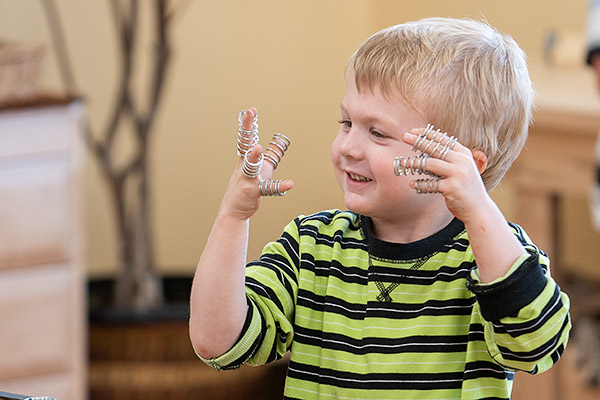
Young children are constantly exploring with all their senses
Children who can’t effectively regulate all of this sensory input or who are still learning how to manage ongoing sensory stimulation often struggle with related challenging behaviours. As educators and caregivers, we can help children of a variety of ages fine-tune and maintain their sensory health. Whether in a school or home environment, adults can provide tools to promote healthy sensory development, thus guiding our children toward the ultimate goal of self-regulation.
Start with movement
A logical place to begin promoting SI is by providing frequent opportunities for movement, ideally whole-body, unstructured play multiple times a day. However, a variety of movement opportunities is also important. Children are internally driven to run, jump, swing, climb, balance, and spin, especially outdoors. They need to be upside down, to bounce, to crawl as well as walk, and to stretch, slide, and use active tools such as bicycles, scooters, and skates. And yes, sometimes this can mean they even need to take developmentally appropriate risks in active play. Why? Learning to evaluate and manage these risks will help them to develop confidence, problem-solving abilities, and resilience.

Children need whole body, unstructured play multiple times a day
Children are engaging daily with screens more than in past decades, and parents may find that helping their children physically engage with their environment is more challenging than ever. Provide a dedicated time each day for children to move, fully separated from electronics. Here are some ideas for materials and activities that can be utilised at home, both inside and outside:
- A climbing rope, tree swing, or tire swing allows children to climb, spin, and swing at home.
- Mini trampolines, spinning toys (such as a Sit’n Spin), balance boards, or hopper balls encourage bouncing and balancing.
- A hanging bar or indoor swing (such as a cuddle swing, rocker, or swing chair) can help children both expend energy and settle down, especially on days when you have to be inside.
- A child-sized wheelbarrow with a shovel inspires “heavy” work. Two-litre bottles (filled with water) or an old set of encyclopaedias, books, or magazines are easily accessible items that children could move or carry. (Be sure to structure the activity appropriately for your child’s size and weight.)
- A sensory table could be made with one or two dishpans filled with materials that you can change each day – e.g., sand, dried beans, pasta, rice, shaving cream, water, beads of varied sizes, popcorn, shredded paper, packing peanuts.
- A variety of fine-motor and art materials, such as clay or dough in multiple textures, painting and drawing (vertically on a wall or easel as well as flat on a table), and practical life activities (stringing beads, pouring between two containers, transferring using tweezers or a spoon) should be provided and periodically rotated.
Give opportunities for both structured movement (such as yoga, a dance class, sports, or an obstacle course) and unstructured, active play time when children lead the way. Movement periods don’t always have to be lengthy; taking short “brain breaks” in the midst of other activities can help children (and parents) reset attention and come back ready to re-engage.
Look at the physical environment
When teachers design a classroom environment, they have to support a broad range of learners. At home, you have more flexibility to think about the needs of your particular children, but you also need to support them over multiple years of their development. Take a look at your own home as you consider some of the following environmental factors, and then think about some small adjustments you might make for your particular child(ren).
- Room layout: Is there space for children to be noisier or quieter, to work individually or with others?
- Variety of activities: Do children have choices of activities, whether in level of stimulation, physical engagement (e.g., gross or fine motor, standing or sitting), or interaction with others?
- Visual organization: Are toys and materials clearly organised and accessible by children without adult assistance? Do walls and other surfaces have a balance of filled and empty space, to allow for visual rest? Are both natural and incandescent lighting available, at a variety of heights and levels of intensity? Can children help maintain their own well-ordered environment?
- Seating considerations and “time in” options: Do children have chairs, stools, and/or floor seating available, some specifically designed for their size, and in a variety of textures, heights, and levels of firmness? Is there a quiet, individual space where the child can choose to go to “reset”, perhaps with a rocking chair, headphones (with or without music), fish bowl, and hand-size fidgets (e.g., squeeze balls of varying textures and firmness levels)?
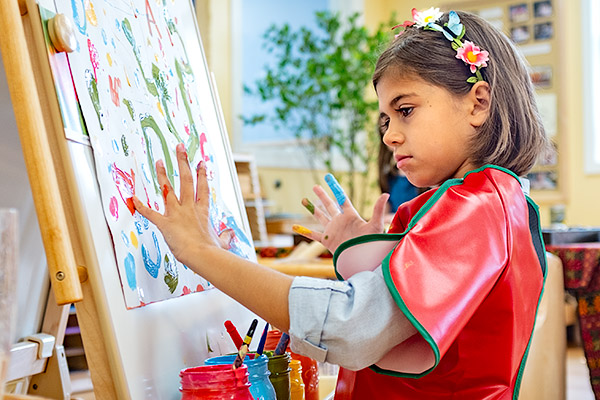
Children need uninterrupted time to explore activities of their own choice
Whatever your environment, providing your child with daily routines, clear expectations with age-appropriate supports, and well-planned transitions (with advance, repeated notice, particularly for younger children) will give predictable structure to the day and help your child know what to expect. Just as we adults feel more in control when we know what is coming, so do our children. Transitions become less of a struggle when children are prepared for them early and often.
Promote independence and responsibility
One opportunity available to us particularly during this unusual period is promoting independence in our young children. Our 21st century American culture typically has us running from place to place and activity to activity, with all too little downtime for both ourselves and our children. Age-appropriate independence, balanced with responsibility, is an incredibly useful tool for children, one that ties intimately to the self-regulation required for them to be successful in school, and ultimately in life. Both independence and responsibility must be developed sequentially, consistently, and over an extended period of time in which the child can direct and manage her own activities.
As you begin thinking about how to promote independence at home, once again consider aspects of both your environment and your child’s ability to freely and purposefully move. Here are some places to start. You will need to adjust as appropriate for your child’s age and developmental stage – but remember that young children are generally much more capable than we give them credit for!
- Can my child provide for his own needs, such as access to water, healthy snacks, and bathroom facilities, without my assistance?
- Does my child have a quiet place to go to be alone, whether to enjoy solitary activities, just sit and daydream, or to reset if needed? Does she have access to this place whenever she desires or needs it?
- How often does my child get uninterrupted time to himself to explore activities that he chooses? For how long at a time?
- Is my child’s living and sleeping space structured so that she can access and maintain it herself, from choosing clothes to wear to making her own bed each day?
- When my child has a challenge, does he have the opportunity to solve it himself?
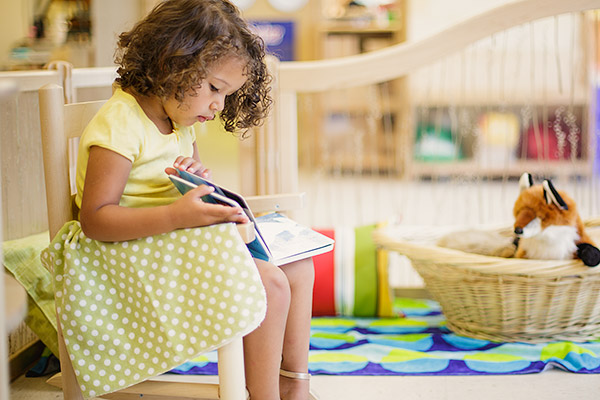
Children also need places and times of quiet to reset
These do not mean that our children need unlimited freedom and unsupervised or uncontrolled lives. Children have limited judgement, and we, as the adults, are responsible to care for them and ensure their safety. But we are able, with careful, conscious forethought, to help set up prepared environments which support children’s developmental needs. Ultimately, this will help them move toward an independent adulthood and prepare them for future challenges.
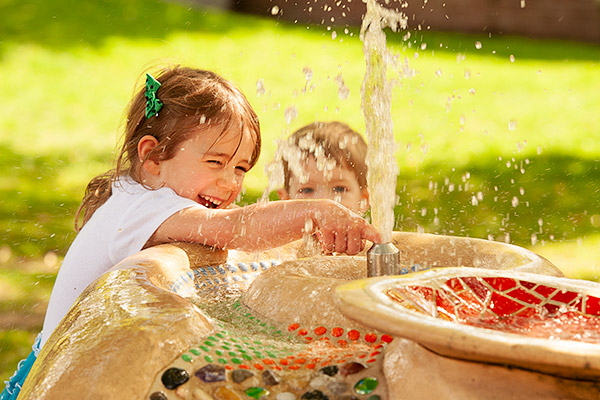
Supporting young children’s developmental needs ultimately helps prepare them for future challenges
Curious about other ways to support your child’s sensory development, growing independence, and sense of responsibility, or to cultivate self-regulation and resiliency? Please share those thoughts, and we will look for opportunities to explore them further in future blog posts. In the meantime, I hope that you are able to capitalise on this most unusual time to help your children reconnect with simpler pleasures which will provide dividends for years to come.




